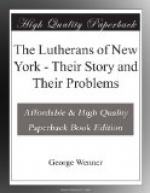After the Revolution of 1848 in Germany, immigration to America increased by leaps and bounds, and within the time under review New York was referred to as the fourth German city in the world. But the Germans, as we have seen, did not all go to church. The existing churches, it is true, were well filled, but a large proportion of the population, torn from the stable environment of their homeland life, and transplanted into the new conditions of a crowded city, failed to respond to the claims of their ancestral religion.
In our church polity there was no adequate provision for the needs of such an immense and ever expanding population. Now and then a broadminded pastor would encourage the planting of a church in some needy field, but too often the establishment of a new mission was looked upon as an encroachment on the parochial rights of the older congregation. At this point in the congregational polity of our church the absence of a directing mind and a unifying force was sorely felt.
The condition of immigrants at the port of New York was for many years a public scandal. In 1847 the State of New York appointed Commissioners of Immigration. Under the Act of March 3, 1891, the Commissioner was appointed by the Federal Government.
Before this was done, the helpless immigrants were the prey of countless vampires, chiefly in the form of “runners,” agents of boarding houses and transportation companies. These pirates of the land exacted a heavy toll from all foreigners who ventured to enter our city by way of the steerage.
[illustration: “Pastor Wilhelm H. Berkemeier”]
In 1864 Robert Neumann, who had been a co-laborer with Gutzlaff, a pioneer missionary in China, established an Immigrant Mission at Castle Garden and succeeded in awakening an interest in this cause.
A few years later, in the subsequent period, the churches took up the question of providing for the needs of the immigrants.
The Deutsches Emigrantenhaus was incorporated in 1871. Pastor Wilhelm Heinrich Berkemeier became the first housefather. His unflagging zeal gave strong support to a much-needed work of love. His venerable personality was a benediction to his contemporaries.
In the course of the years eight Lutheran Immigrant Houses and Seamen’s Missions have been established at this port and are doing effective Christian work.
Toward the close of this period, in 1864, a seed was planted on the Wartburg near Mount Vernon which has grown to be a great tree.
Peter Moller, a wealthy layman, had met with a great sorrow in the death of his son. He was planning to expend a large sum for a monument in memory of this son, when Dr. Passavant, an eminent worker in behalf of invalids and orphans, called upon him, perhaps with the hope of obtaining a contribution for some of his numerous charities. To him Mr. Moller confided his purpose. It did not take long to outline the plan of a nobler memorial than the proposed shaft in Greenwood. With $30,000 a hundred acres of land were bought and a house of mercy was established which for fifty years has been a blessing not only to the orphans who have been sheltered and trained there, but also to the churches of New York that have been privileged to contribute to its support.




